Behind the Seams of Today’s Princess Diana Fashion Auction
My hands-on (literally!) preview of the clothing and accessories up for sale.
I walked into an expansive suite at the Peninsula in Beverly Hills this week, looked up, and took a deep breath. The space was teeming with pieces that once belonged to Diana, Princess of Wales. Several of her glamorous gowns, displayed on mannequins, caught my eye first, then I zeroed in on the coffee table filled with her shoes and handbags. Along the back table was a trio of hats; hand-signed holiday cards covered the grand piano.
Michael Amato, a fashion specialist for Julien’s Auctions, greeted me warmly and said, “Let me grab you a pair of white gloves.”
Based in Beverly Hills, Julien’s is known for its sales of film, music, and sports memorabilia. (Remember the dress Marilyn Monroe wore to sing JFK happy birthday, the same one that Kim Kardashian wore to the Met Gala? Back in 2016, that was sold at a Julien’s auction for $4.8 million.)
Earlier this year, Julien’s set a record with the highest hammer price for a Princess Diana dress, fetching $1.14 million for a Jacques Azagury ballerina-length design she wore in 1985. After that sale — as one might imagine — people in possession of Diana pieces reached out to the auction house. “It caused quite a stir,” Amato told me when we first spoke over the phone. “People were like, ‘Oh! There’s another Di-mania happening.’”
Gathering items from a variety of collectors, Julien’s has put together one of the biggest Diana sales since 1997, when the princess herself auctioned off dozens of her own gowns. The idea for the sale came from a teenage Prince William; it was meant to raise money for her charities, as well as free up space in Kensington Palace and mark a new chapter for the princess after her divorce. In the years since her death, Diana’s pieces have regularly popped up at auction houses around the world.
Julien’s sale, which takes place today, June 27, is called “Princess Diana’s Elegance & A Royal Collection.” The pieces with ties to Diana headline the auction but the 205 lots include other royal memorabilia as well (including items belonging to the Duke and Duchess of Windsor, formerly King Edward VIII and Wallis Simpson).
I reached out to Amato to learn more about the show, particularly the Diana fashion; he then invited me to the Peninsula for a preview of the auction. Wearing the aforementioned white gloves, I got to (carefully!) see — and, unbelievably, touch — what was on display. Together we examined the construction of the garments, studied the wear of her shoes and handbags, and looked underneath the brims of her hats.
I never saw the late princess in person. But the surreal hour I spent in the hotel suite made it possible to visualize her in a new way — all thanks to her fashion. Diana was tall, standing 5-foot, 10-inches, which I felt standing near the mannequins displaying her clothing. Her bold style choices, leaning into saturated color, unique silhouettes and eye-catching embellishments, must have made her stand out even more. And yet, nothing felt looming. Rather, lithe is the word that comes to mind. Her hats were not as large as I expected nor were her shoes (one pair was marked size 8.5). Her accessories had a whimsy to them, like fun accents. What a presence she must have had.
Below, you will find my chat about today’s auction with Amato, with his thoughts on why collectors invest in fashion, how “economic” Diana was with her style, and why her fashion remains relevant today. Keep scrolling for more on what I saw at the Peninsula, including the smallest stitching I can’t stop thinking about, two gowns with unexpected pops of pink and the message Diana signed in her holiday cards.
The auction gets underway today, Thursday, June 27, at 10am PT. You can view the full assortment — and register to bid — here. Julien’s has invited me to attend, so I’ll be sharing what I can over on Instagram. Join me, won’t you?
(This email will likely get cut off in your inbox, click here to read it in full. As always, these missives are prettier on your computer browser than they are on your phone.)
Behind the Seams of Today’s Princess Diana Fashion Auction
Please note: This conversation has been edited and condensed.
Before we get into the specifics of this auction, I want to understand fashion auctions. Are they on the rise? And who buys these pieces?
Michael Amato, fashion specialist at Julien’s: Fashion auctions have grown in the last 10 years with hammer prices exceeding their high estimates by a large margin. There is slowly becoming more of a collector following. Buyers can range from someone with a private collection to acquiring something for a museum. I know Kensington Palace has bought back some Diana property to have in their archives.
You also have investors that see it as a way of building their own investment portfolio — especially because these pieces have built-in marketing. When you have a dress worn by Princess Diana, you have a really cool, fabulous fashion design but you also have a cultural moment that you can advertise and play with. It’s a once-in-a-lifetime event that surrounds it, a way of storytelling with something that already has a story.
I have always wondered: What people do with the fashion once they buy it?
People who acquire these pieces have a range of reasons. Sometimes it’s philanthropic. We auctioned off a Bruce Oldfield gown and two Catherine Walker pieces in September. The original owner, who bought them from Diana’s auction in 1997, put them on display to fund charities for children with special needs.
Clothing is different from paintings or fine art, where you can have it on display permanently. In order to preserve textiles for a longer amount of time, you need to be able to store the piece in a facility that’s temperature controlled and be able to lay it horizontally versus vertically. You can have it on display for certain amounts of time, for previews and exhibitions, but you really shouldn’t have it on permanent display for a long amount of time. It causes stress at the seams and further wear to the fabric.
Tell me about the Diana pieces included in this sale.
This is actually one of the largest auctions to have Diana property since 1997 [when the princess auctioned off her gowns for charity]. The pieces came from a variety of collectors. It includes gowns that were originally auctioned off in 1997 as well as personal items and accessories that were owned by Diana. [EH note: More on these pieces below.]
We also have cards and letters, written in her hand and signed by her, to a longtime friend and housekeeper from Althorp. There’s a personal element to them that shows how she connects to people within her life, how open she was, whether they are friends or worked with her.

Diana’s fashion continues to hold such appeal, all these years later — why do you think that is?
It’s an emotional connection to the princess. After she married Prince Charles, she was still young. A lot of us get to grow up and play with fashion, but when you are put under a microscope — and restrained in terms of how you are able to communicate — you find ways of feeling liberated. She chose fashion, with bolder colors, more dramatic silhouettes, more fitted bodices and cinched waists. She wanted to show she was young, she wanted to play. I think that invited more people to comment on her clothes and feel more attached to what she was wearing.
What did you learn about Diana while cataloging these pieces?
She was so considerate in her clothing. She not only wore something because it was an attractive piece of clothing, but also because it was nice for the person who was receiving the princess. I noted the fact that, on public appearances, she wore certain types of fabrics to help people feel at ease. When she went to hospitals or as patron for certain types of charities, she purposefully wore velvet. When she was hugging and embracing them, they felt a softness to her — more inviting and calm.
You can also see she was very economic in her fashions, which a lot of people probably didn’t realize then. Now there are celebrities who recycle red carpet looks and are more conscious about wearing vintage to premieres and award shows. But Diana re-wore the same gown to numerous events or on public tours. She gave the designers a platform that wasn’t a fleeting moment. She wore it again, showing that she really liked these designs.
One of the skirts in the auction is a pleated wool skirt by the Chelsea Design Company, which is a Catherine Walker label. It dates from the early eighties and she wore it through until the nineties. She was very practical and relatable in that sense, much like how we keep a denim jacket and wear it until there are holes in the elbows.

I have been so fortunate to talk with a lot of designers who worked with her, from Jacques Azagury to Victor Edelstein, Butler Wilson, Elizabeth Emanuel. They really have given me so much insight into who she was as a person. A lot of people think what you see isn’t who that person is — it could be a façade. But everyone explains the same story, how lovely she was and how when she went to these previews she didn’t just talk to the designers, she talked to all the people involved. She appreciated the fabric, she appreciated the design. She wasn’t someone that took any of that for granted. It’s not just something that was made to be worn and then forgotten.
I don’t know if she knew how much of an impression her fashion has made in the past, but you can tell there is still such an interest. There is a longevity and a narrative that constantly speaks to people.
Now, for a closer look at some of the standout auction items…
Lot 8 — Victor Edelstein Black Lace and Magenta Silk Dress
Worn twice in 1987, in London and again in Germany

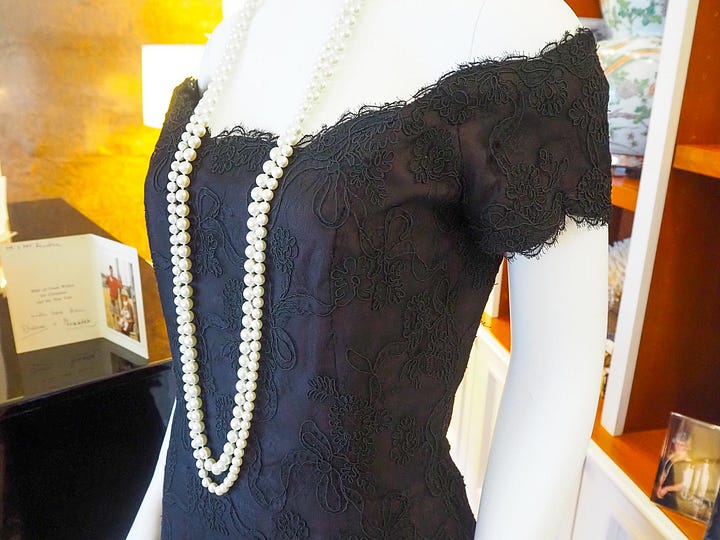
Michael Amato: Diana had input in her clothes. She wasn’t a person who had a bunch of things delivered and just wore them. For example, take this black lace design with a tiered skirt lined with magenta silk. It was originally black and gold in the design for Edelstein’s show. But when they discussed it, he modified it for her and it became black and magenta. She knew what worked for her, she knew what she liked, and she wasn’t someone who dressed to appease people. She dressed for herself.
EH note: The magenta lining here is so subtle! It only shows up in some pictures. Even in person, you have to look very closely to see it. But it does feel significant. It was a big deal for Diana to wear as much black as she did (the color is often avoided by the royals because of its associations with mourning). The addition of magenta livens the whole dress up, and reminds me of Diana’s playful side.
Lot 12 — Catherine Walker Yellow and Navy Skirt Suit
Worn on the 1989 tour of Hong Kong, as well as Trooping the Colour in 1991
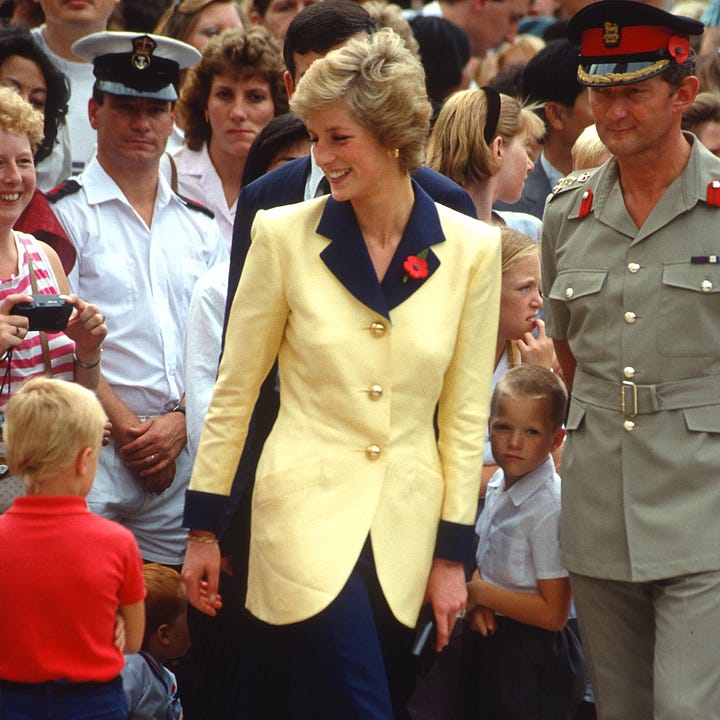
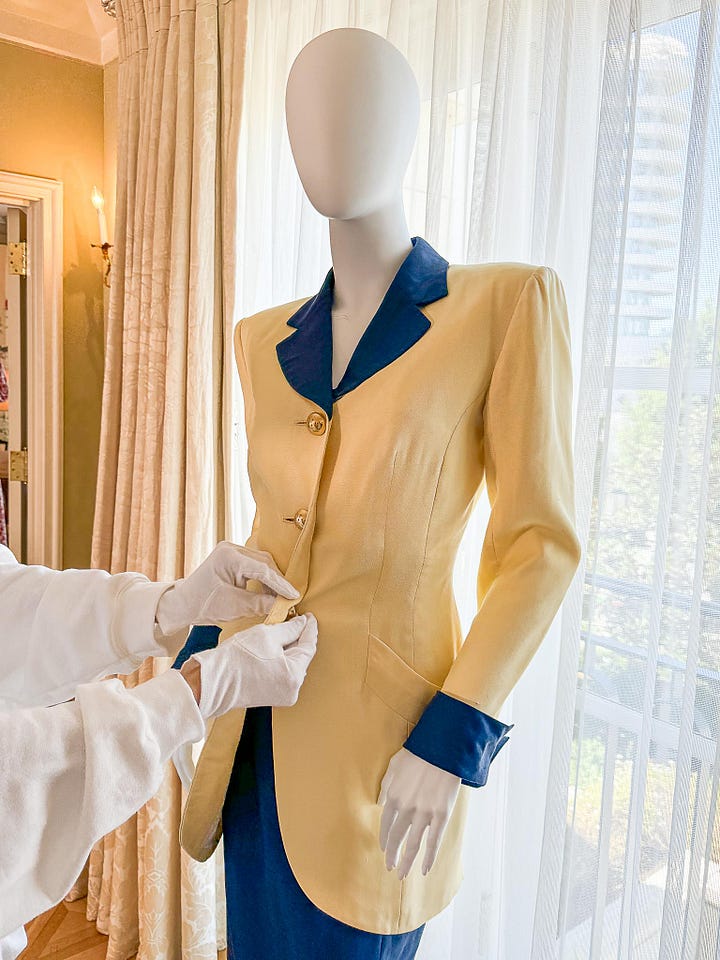
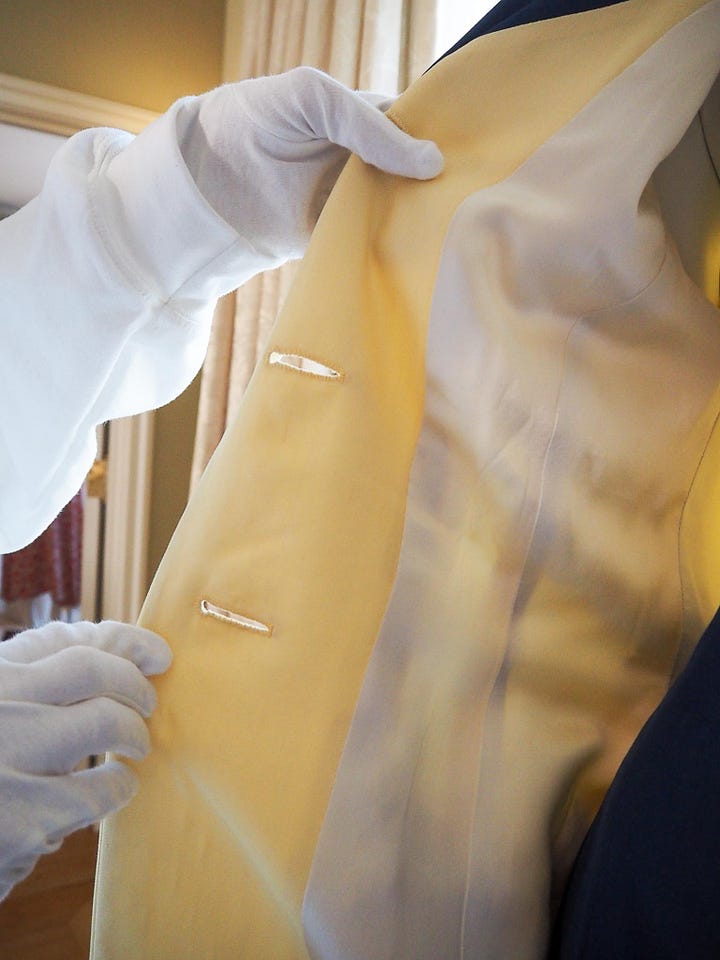
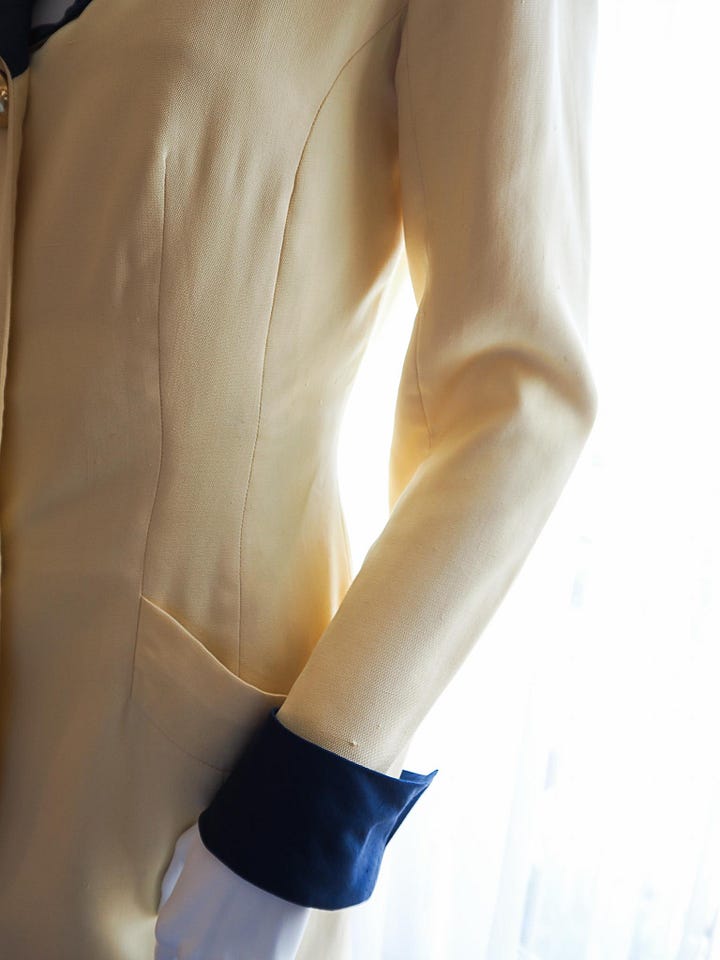
MA: Catherine Walker was able to devote so much more time to Diana’s pieces. A lot of couturiers and British designers could only afford to do one or two things for her because it costs so much money for the fittings and all that. Catherine Walker set up a business where she was able to produce ready-to-wear for her clientele but she was also able to devote time to Diana.
This blazer has a very menswear, tailored, single-breasted type cut but it’s nice how Walker balanced the navy with a soft canary yellow. The lining is beautifully inlaid into the garment and then piped. You can see certain types of seam work in pieces that are custom-made specifically for Diana. There was so much effort put into tailoring the garments. You have the slight darting and the way the pockets are cut on the diagonal so it elongates her.
I think that’s why Diana really gravitated towards Catherine Walker, because her tailoring really emphasized a lot of things about Diana that she liked people to notice.
EH note: Maybe my favorite detail of the preview was what I spotted on the underside of the blazer’s lapel (above). You can can see a careful series of small stitches in neat lines, which Amato said would have been done to avoid puckering. Later, he unbuttoned the jacket, revealing a skirt that was much more high waisted and fitted than I anticipated.
Lot 5 — Murray Arbeid Blue Tulle Diamante Star Gown
Worn at least four times, including twice in 1986, again to the ballet in 1987, and in 1997 for a portrait with Lord Snowden.
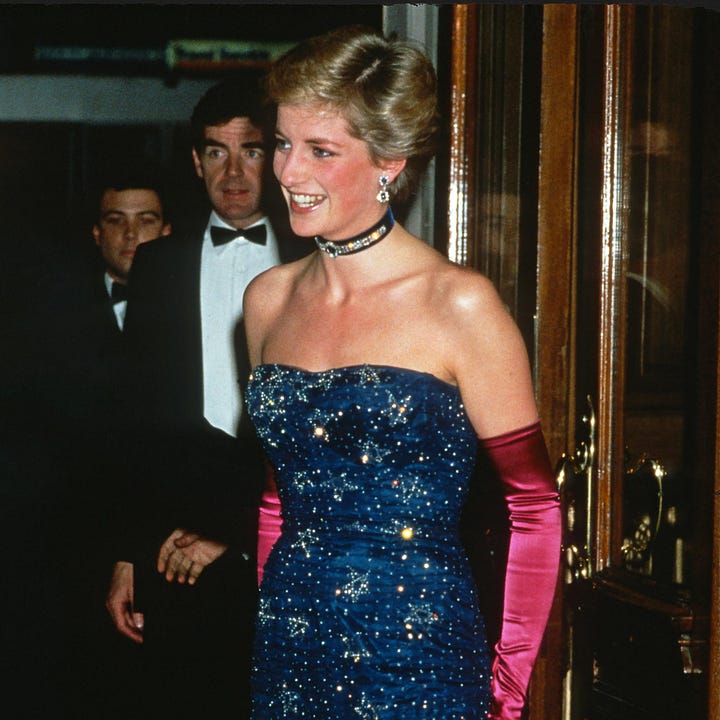



MA: It’s very interesting to differentiate the custom pieces from ready-to-wear. She did buy off the rack, like this star gown. You would think that’s a haute couture dress because of its bone bodice, made of ruched tulle, with the layered skirts and the diamanté embroidery. But it’s a ready-to-wear design that’s beautifully made.
EH note: The dress reads as mostly a deep purple in pictures, veering on navy. But in person, you can see the darker rose under layer of the bodice — it felt similar to the earlier Edelstein dress (a Diana slideshow, perhaps?). The stars are clearly appliquéd on, while the hem is stiff and structured, allowing the skirt to keep its ripple shape. It’s a very fun piece that, to me, represents where she was with her fashion by the mid-80s, willing to take risks. I love that she re-wore it a decade later for a formal, posed portrait, too.
Lot 20 — Catherine Walker Black Velvet Evening Gown
Not worn in public; sold in 1997 as part of Diana’s own auction
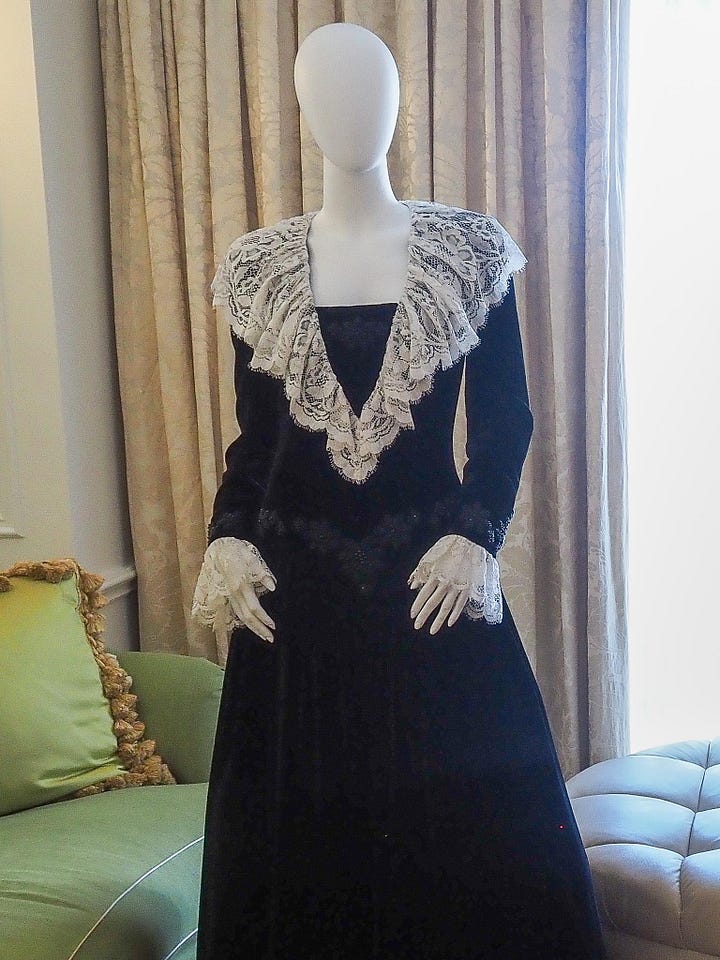

MA: Diana wore a lot of these basque-waist dresses, which do a little more contouring. In this black velvet Victorian-era gown, there are two zippers. There is a zipper going up the bodice and then there is a zipper down the skirt. They meet right right below the waist.
That type of construction is really fascinating to study. A lot of designs today have to be very cost effective and efficient, so there are not that many seams. There are not that many openings. There are not that many fitted darts. Not a lot of us have the opportunity to be fitted with a couture garment. Sometimes we get to go to a tailor and they put in special alterations, and that’s a thrill as well. But it’s something different entirely when you see a whole workroom design and make something specifically for you.
EH note: This dress is such a vibe! It’s big and heavy, with lots of lace and quite a bit of intricate beading. I wonder if Diana had an intended public outing for this piece? Or was it something she wore in private? It feels like a window into the ways in which she was open to experiment or lean in with bolder design choices.
Accessories — shoes, handbags, hats

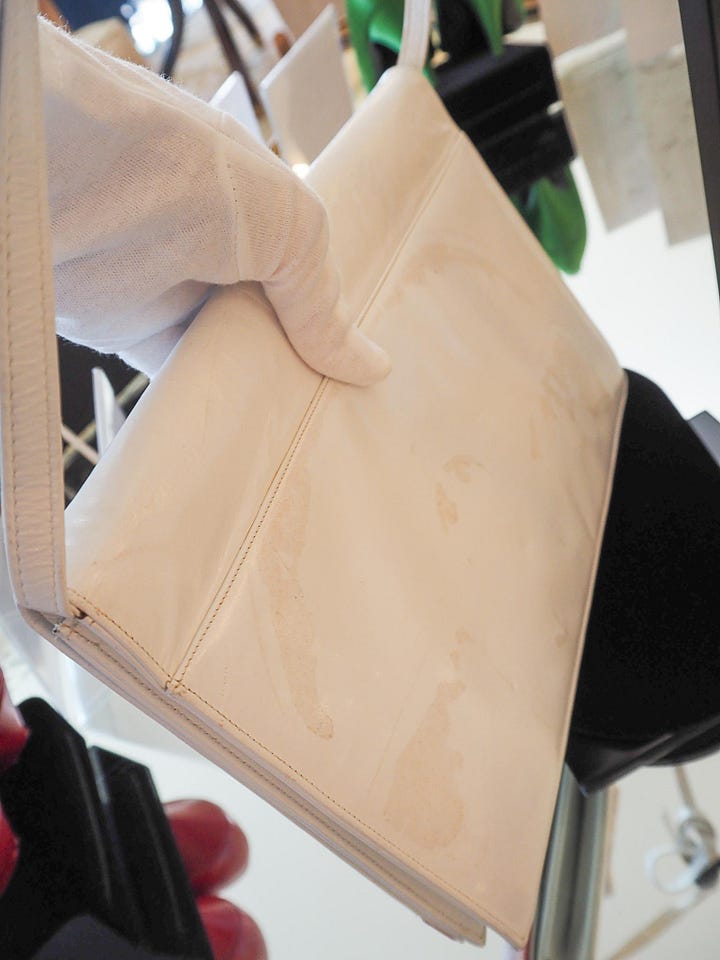
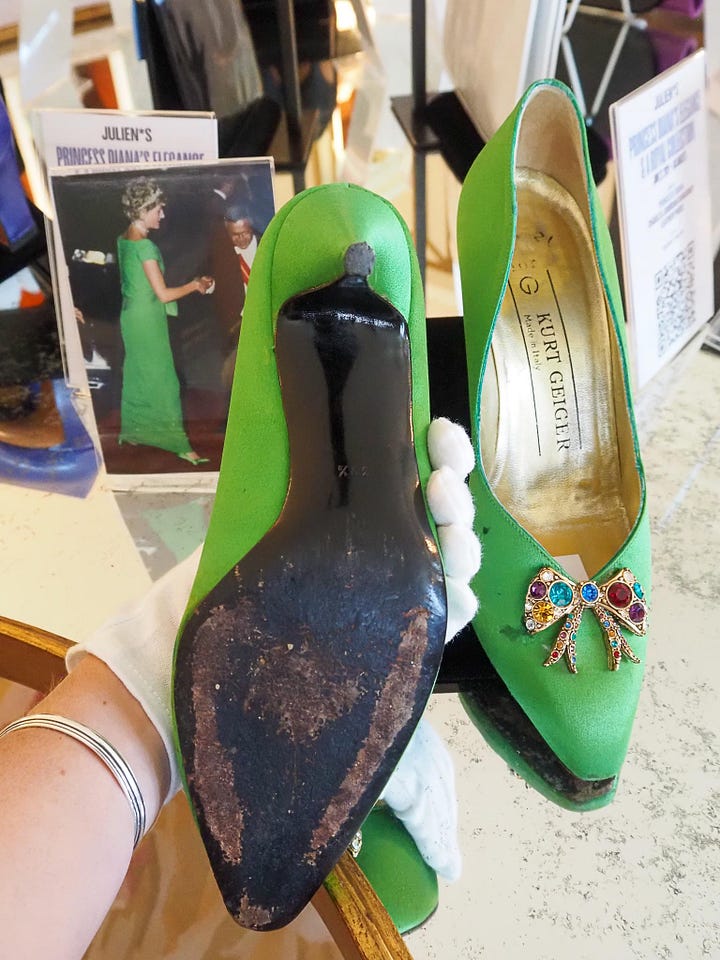

EH note: These pieces really brought the princess to life in an unexpected way. I could complete the picture in my head. Her shoes were all quite worn, not just on the soles but around the sides. One pair was marked size 8.5, which is smaller than I expected for someone of her height. The handbags, including a cross-body red and white bag worn in Japan and a purple clutch taken on tour in India, both by Rayne, were astonishingly narrow. They would hold very little — maybe a lipstick? — without signs of bulging. This supports my theory that clutches serve as more of a hand-occupying role than anything else! (Diana famously used them when she exited a car, too, covering her chest.) As for the hats, they were stunning — pieces of art, really. They must have added considerably to her ensembles.
Correspondence — wedding invitation and program, letters, holiday cards
EH note: I wasn’t expecting to be as moved by these pieces in the auction as I was. There are more than a dozen holiday cards and letters sent to Maud Pendry, the housekeeper at the Spencer estate of Althorp. There is a real warmth to Diana’s correspondence with “Mrs. Pendry.” The princess didn’t write lengthy notes, but the sheer volume of these letters reveal a longstanding friendship.
With the holiday cards, it was interesting to note how the design stays largely the same each year while Diana’s message varies ever so slightly. (Examples include “Lots of love from” or “With love from us all” or “So much love from the four of us.”) I wondered, too, how many of these cards she would sign? I am enchanted by how difficult it is to decipher her hand-writing in some. It is so bubbly and informal. Is that how she wrote always or was she in a rush with these?
Among the other letters to Mrs. Pendry, Lot 33 jumped out. Dated July 29, 1984, it was a thank you note Diana sent after receiving an anniversary card. “What with the baby arriving soon,” she wrote, referring to Harry, “our lives seem to be very busy, but we’d have it no other way!”
My thanks to Michael Amato and the team at Julien’s for this special preview.
The auction, “Princess Diana’s Elegance & A Royal Collection,” is set for TODAY Thursday, June 27 at 10am PT. You can view the lots and register to bid here. Join me over on Instagram as I share what it’s like to attend the sale.

















It is striking to me that in the holiday card you showed, it looks like Charles signed his own name; the handwriting is clearly different from the rest of the card. That says a lot to me; most cards I get, (even from my own parents!), have both names but are signed by just the wife. I really like that it was important to Charles to sign the card himself, if I'm looking at it correctly!
Thank you for sharing this experience and your analysis, Elizabeth!!
This is my favorite piece you’ve done so far, Elizabeth! I just loved Michael’s story about Diana wearing fabrics that would feel good and offer comfort to the person hugging her, and it’s fascinating to get this up-close glimpse of how Diana’s clothes were constructed and the wear they received. I also appreciated your Instagram coverage of the auction. Great work, thank you!